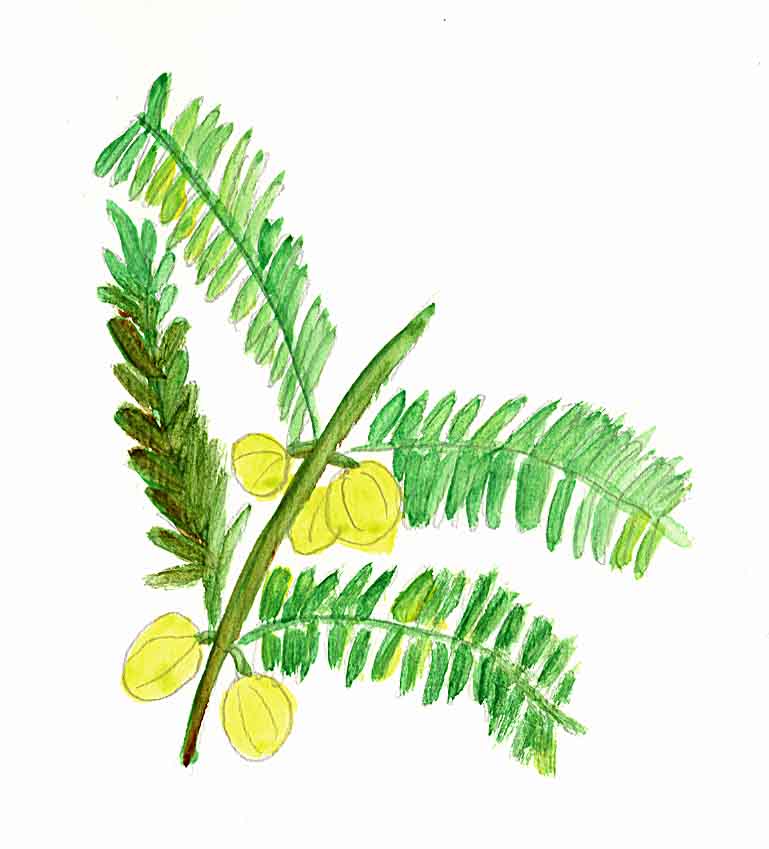Contribute
| Purslane - Amla |
Usha Palaniswamy Ph.D., M.Ed.
01/18/2005
Introduction
Amla (Phyllanthus emblica [Emblica officinalis ], Euphorbiaceae), is native to the tropics of southeastern Asia, specifically India, Pakistan, Bangladesh, Sri Lanka, Malaysia, and China. It is also called emblic or anola. The Sanskrit name for amla is amlaki, which means "the sustainer" or the "fruit where the Goddess of prosperity resides." The Hindus worship this tree as the Mother Earth and traditionally, ripe amla fruits are prescribed to be eaten for 40 days after a fast in order to restore health and vitality. The fruits are known for their thirst quenching ability and eaten with salt and chili powder as an every day snack even today by most people in India, Pakistan, Bangladesh and Sri Lanka. The tree is a common backyard tree grown for the fruits that are used throughout the year as fresh fruit or preserved as pickles.
Cultivation and Traditional Uses
Amla is commonly cultivated in home gardens as well as a commercial crop throughout India, Singapore, and Malaysia. Amla grows well in tropical and subtropical climates and can thrive in sandy loamy soils with good drainage. Amla is propagated by seeds, which are normally sown to obtain a spacing of 30 to 40 ft (9-12 m) between trees. The trees start to bear after 5 to 6 years of planting and normally bear for over 50 years. All parts of the tree are reported to be useful to human beings. Fresh fruits are used in the kitchen as a seasoning and to add flavor and taste to numerous dishes, often as a substitute for tamarind. Fruits are candied, made into jam and other preserves, pickles, relishes, and chutney.
The dried fruits are used to make ink and a hair-dye and, often used to wash and condition hair. Oil extracted from the fruit is used as a hair-restorer in the manufacture of herbal treatments, hair oils and shampoos in India. The bark rich in tannin is used in the tanning industry for tanning leather. The leaves are used as fodder and also as green manure and often ploughed into the soil to correct alkalinity. The wood from the tree is used for minor construction and furniture. The whole plant especially the fruits have been used as an anti inflammatory and antipyretic agent in many medical systems including Chinese herbal medicine, Tibetan medicine and Ayurvedic medicine. It is also regarded in these world cultures as a traditional immunomodulator and a natural adaptogen and names Amla as an important traditional medicine with "broad prospects" (Xia et al., 1997). The leaves and fruits are used for the anti-inflammatory and antipyretic treatment of rural populations in China, India, Indonesia, and the Malay Peninsula.
Amla is used in Asian traditional medical systems as an antiscorbutic, in the treatment of digestive problems, for jaundice, and cough, as a diuretic and laxative. Amla is an essential ingredient of the Ayurvedic preparation Triphala, which is prescribed by the traditional medical practitioners for dysentery and liver problems, indigestion, anemia, cardiac problems and nasal congestion. The root bark is used to treat wounds and also applied to inflammations of the mouth. The fruits and seeds are steeped in water and used as drinking water in homes.
Botany
The amla tree is a deciduous tree growing to a height of 60 ft (18 m). The stem bark is smooth and peels off which makes it a preferred ornamental tree in homes and gardens. The leaves are very fine and small, only 1/8 in (3 mm) wide and 1/2 to 3/4 in (1.25-2 cm) long and oblong. The flowers are small, greenish-yellow and borne in compact clusters in the axils of the lower leaves. The fruits are round or oval, with smooth textured skin. There are ~6 to 8 pale visible lines, appearing as ridges, extending from the base to the apex. The unripe fruits are light green turning a yellow to red at maturity. The fruit is hard to touch and its thin translucent skin is firmly attached to the crisp, juicy flesh of the fruit. The stone is tightly set in the center of the flesh and contains 6 small seeds. Ripe fruits are astringent and extremely sour to taste.
Current Use and Health Value
A study reported that about 17 countries and nations of the world use various parts of amla tree in their medical treatment (Xia et al., 1997) and the attributed medicinal properties include anti-hepatitis, anti-cancer, anti-tumor and regulation of stomach function. Modern laboratory and clinical studies report results from controlled experiments that show evidence of potent antioxidant activities of amla extracts (Bandyopadhyay et al., 2000, Khopde et al., 2001, Ghosal, 2000), and has been recommended for the treatment of oxidative stress, for the modulation of the immune system and for the inhibition of the protein kinase C and cholesterol biosynthesis (Wagner & Gebhardt, 2000).
Amla extracts also showed antimicrobial and cytotoxic activities (Jasril et al., 1999), inhibitory on human immunodeficiency virus-1 (El-Mekkawy et al., 1995), as well as anti-inflammatory and anti tumor properties (Sur et al., 1998). The amala extracts also significantly inhibited hepatocarcinogenesis (Jose et al., 1999), protecting the liver (Gulati et al., 1995). Amla is one of the major ingredients of the ayurvedic drugs Anna Pavala Sindhooram which is prescribed as an antiatherosclerotic drug and Triphala, is effective in preventing superoxide-induced hemolysis of red blood cells (Vani, et al., 1997). Extracts of amla leaves showed inhibitory activity on platelets, which confirm the anti-inflammatory and antipyretic properties of this plant as suggested by its use in traditional medicine (Ihantola-Vormisto et al., 1997).
References
Bandyopadhyay SK, Pakrashi SC, Pakrashi A. 2000. The role of antioxidant activity of Phyllanthus emblica fruits on prevention from indomethacin induced gastric ulcer. J Ethnophamacol 70(2):171-176.
El-Mekkawy S, Meselhy MR, Kusumoto IT, Kadota S, Hattori M, Namba T. 1995. Inhibitory effects of Egyptian folk medicines on human immunodeficiency virus (HIV) reverse transcriptase. Chemical Pharm Bull 43(4):641-648.
Ghosal S. 2000. Pharmaceutical, cosmetic, and nutritional formulations containing natural antioxidants from Emblica officinalis fruit. PCT Int Appl 39.
Gulati RK, Agarwal S, Agrawal SS. 1995. Hepatoprotective studies on Phyllanthus emblica Linn. and quercetin. Indian J Experimental Biol 33(4):261-268.
Ihantola-Vormisto A, Summanen J, Kankaanranta H, Vuorela H, Asmawi ZM, Moilanen E. 1997. Anti-inflammatory activity of extracts from leaves of Phyllanthus emblica. Planta Med 63(6):518-524.
Jasril, Mohamed SM, Mackeen MM, Lajis NH, Rahman AA, Ali AM. 1999. Antimicrobial and cytotoxic activities of some malaysian flowering plants. Nat Prod Sci 5(4):172-176.
Jose KJ, Joy KL, Kuttan R. 1999. Effect of Emblica officinalis, Phyllanthus amarus and Picrorrhiza kurroa on N-nitrosodiethylamine induced hepatocarcinogenesis. Cancer Lett 136(1):11-16.
Khopde SM, Priyadarsini KI, Mohan H, Gawandi VB, Satav JG, Yakhmi JV, Banavaliker MM, Biyani MK, Mittal JP. 2001. Characterizing the antioxidant activity of amla (Phyllanthus emblica) extract. Curr Sci 81(2):185-190.
Sur P, Ganguly DK, Hara Y, Matsuo Y. 1998. Antitumor activity of Emblica officinalis Gaertn fruit extract. ACS Symp Series. 701(Functional Foods for Disease Prevention I: Fruits, Vegetables, and Teas):104-113.
Vani T, Rajani M, Sarkar S, Shishoo CJ. 1997. Antioxidant properties of the ayruvedic formulation Triphala and its constituents. Int J Pharmacogn 35(5): 313-317.
Wagner H, Gebhardt R. 2000. Phyllanthus for the treatment of oxidative stress. Ger Offen 26 pp.
Xia Q, Xiao P, Wan L, Kong J. 1997. Ethnopharmacology of Phyllanthus emblica L. J Chinese Material Medica 22(9):515-8, 525, 574.
You may also access this article through our web-site http://www.lokvani.com/

